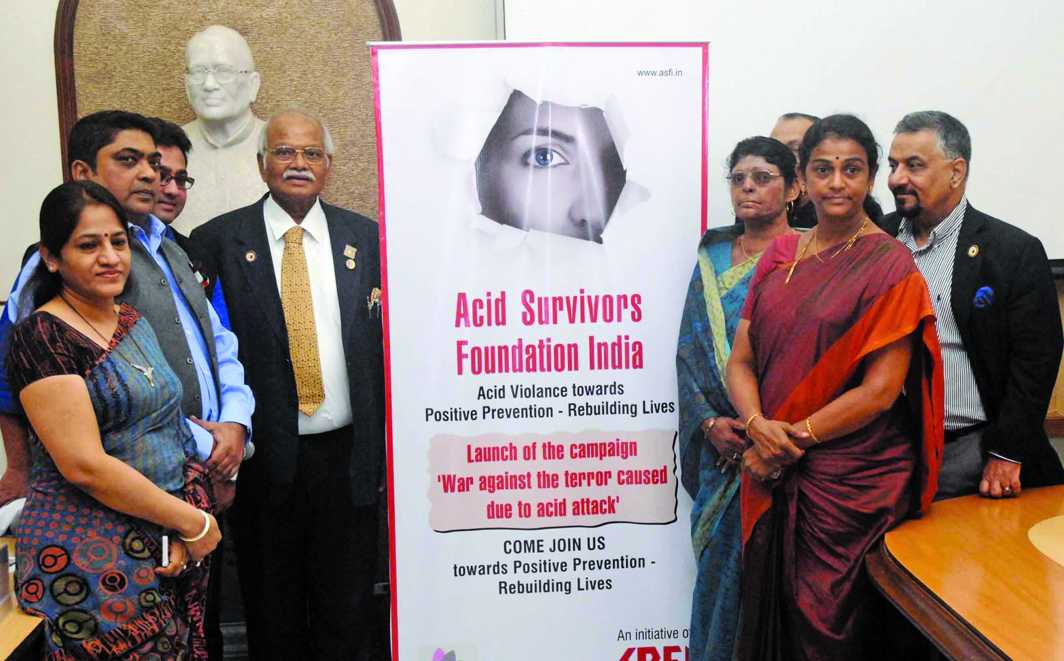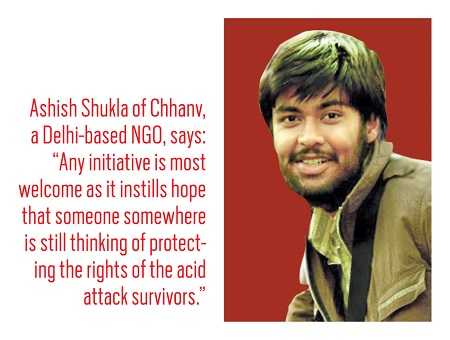
Above: Illustration Amitava Sen
The Uttarakhand High Court’s order providing relief and rehabilitation to these victims is a step in the right direction
~By Usha Rani Das
After becoming the first state to make an acid-attack survivor its ambassador and being a pioneer in granting free medical aid to such victims, Uttarakhand has again set a precedent. In a case that took seven years, the Uttarakhand High Court issued an order on June 12 to fast-track acid attack cases by hearing them on a daily basis and concluding them within a three months’ time-frame.
The Court was hearing an appeal of the state against a judgment passed in 2010 by a sessions judge in Roorkee where it had acquitted a person accused of throwing acid on a 20-year-old student. The High Court also convicted the accused to 10 years’ rigorous imprisonment.
The Bench of Justices SK Sharma and Rajiv Sharma observed: “The incidents of acid burning/throwing cause physical, mental and psychological torture. Every citizen must remember that something which has happened to acid attack victim may also happen with his family members. Every person has a right to life, including the right to live free from any kind of mental, physical and psychological torture, be it stalking, sexual harassment, burning etc. The victim of acid burns is stigmatized and traumatized.” It also issued several “mandatory directions” for rehabilitation of acid attack survivors and for prevention of such instances.
PROBLEM OF IMPLEMENTATION
The steps have been welcomed by activists and survivors. Ashish Shukla of Chhanv, a Delhi-based NGO that fights against acid attacks, told India Legal: “Any initiative is most welcome as it instills hope that someone somewhere is still thinking of protecting the rights of the acid attack survivors.” However, he questioned its feasibility. “Ever since the first law came into effect in 2013, many more have been made to protect the survivors, but not much has been done to implement them effectively.”

In its June 12 order, the High Court said: “The State Government is directed to constitute a Criminal Injuries Compensation Board for the acid attack victims, within a period of four weeks from today (June 12) as ordered by the Supreme Court in (2016) 3 SCC 669, Laxmi vs. Union of India and others and other analogous matters…. All the private hospitals throughout the State of Uttarakhand are directed to provide medical assistance to the acid attack victims as per the dicta of the Supreme Court in (2016) 3 SCC 669, Laxmi vs. Union of India and others and other analogous matters. The State Government is directed to ensure that in every district hospital and joint hospital, specialized ward is provided in the cases pertaining to burn injuries to avoid infection within three months from today. The State Government is further directed to provide free medical aid to the victims of acid attacks till their full recovery.”
FREE AID
Much before the 2016 Supreme Court order (mentioned above), the Uttarakhand government had ordered free medical aid to all survivors in 2013. But Shukla said that even after four years, “no notification has been given to any hospitals from the government and no funds have been allocated. Obviously, no government or private hospitals would have sufficient funds to provide free treatment as the cost often goes beyond Rs 1 lakh.”
The High Court also directed the state government to grant ex-gratia payment of Rs 1 lakh to acid attack victims immediately after the registration of the FIR.
The June 12 High Court order further stated: “The cases pertaining to sexual harassment, stalking, voyeurism and acid burning are required to be fast tracked. The Trial Courts throughout the State of Uttarakhand are directed to hear the cases registered under Sections 326A, 326B, 354A, 354B, 354C & 354D of IPC on day to day basis and conclude the trial within three months and in case, it is not possible to conclude the trial within three months, cogent and sufficient reasons shall be recorded by the Trial Court. The Trial Court shall show due sensitivity in the matters pertaining to the acid attacks.”
Mukul Verma, North India director of Acid Survivors Foundation Initiative, a Kolkata-based NGO, expressed doubts about the successful conclusion of cases within three months. He told India Legal: “We all know fast-track courts are not easy to implement. Even the case of Nirbhaya took one year for a verdict…. Often, pressure is exerted by the perpetrators and his family on the survivors and the police which results in untimely delay of the cases. But Uttarakhand is a small state so it might be easier for it to monitor the cases more effectively.”

But Shukla added the real problem was that there were more fast-track courts available than judges. In some courts, there are no judges. He said: “Due to this, it is almost impossible to conclude a trial within a given time-frame of 3-6 months. Acid attack survivor Salma Khatoon’s case was handled by a fast-track court but no verdict has been given even after two years.”
LOW CONVICTION
Also, the conviction rate of fast-track courts in India is abysmally low. After the 11th Finance Commission recommendations, 1,734 fast-track courts (FTCs), jointly funded by central and state governments, were approved in 2000. As per reports, the central government stopped funding FTCs in 2011 and only 473 are functional now across the country. Also, one criminal case needs at least 20 hearings and most get the next hearing after three months; such is the burden on courts. Even in the Delhi High Court, vacancies of judges are one of the major hurdles in case resolution.
The problem is not just the shortage of judges. Even if a fast-track court is conducted, most often, the culprit gets away by exerting influence. In Salma’s case, two of the five accusers were granted bail by the High Court. Her brother feels even the main accused, Azhar, will be granted bail as his parents are trying hard to prove he is a minor. The High Court has ordered that the eyewitnesses be given protection, but it failed to mention specifics about what steps should be taken to provide security to them.

The High Court order further said: “The State Government is directed to grant ex-gratia payment of Rs 1 lakh to acid attack victims immediately after the registration of FIR and also to pay a sum of Rs 7, 000 per month to the victims who have received third/fourth degree burns injuries. The State is also directed to pay a sum of Rs 5,000 per month, in those cases, where the burns injuries are of first degree and second degree. The victims are also entitled to a sum of Rs 3 lakh as ordered by the Supreme Court.”
SMALL BEGINNING
Verma said that this compensation, though small, is still a good beginning. “The amount will help them in their post-treatment and to buy medicines and expensive lotions,” he said. Shukla said that a monthly amount of Rs 7,000 is not enough to bear the cost of treatment. “This often surpasses lakhs of rupees. Also, there are not enough resources in Uttarakhand, hence the survivor has to travel to cities like Delhi, Bangalore and Chennai for treatment. So the costs go up further.”
Last but not the least, the order stated: “The State Government is also directed to include the victims of acid attacks in the category of physically challenged persons for the purpose of reservation in public employment and also to make separate scheme for their rehabilitation.”
 However, Shukla said they should not be categorised under “physically-challenged”. He said: “This is not justice, it is a betrayal. It is the government’s tactic to get rid of its responsibility.
However, Shukla said they should not be categorised under “physically-challenged”. He said: “This is not justice, it is a betrayal. It is the government’s tactic to get rid of its responsibility.
Acid attack survivors face different challenges from the ‘physically-challenged’. There should be a separate committee to look into their development and welfare. There should be a different quota for them.”
“The process of healing of an acid attack survivor is lengthy and involves different steps—trauma treatment, counseling, rehabilitation, education, etc. By putting them in this category, they do not provide these things in the rehabilitation,” he added.
So even though the order instills hope, more needs to be done.

